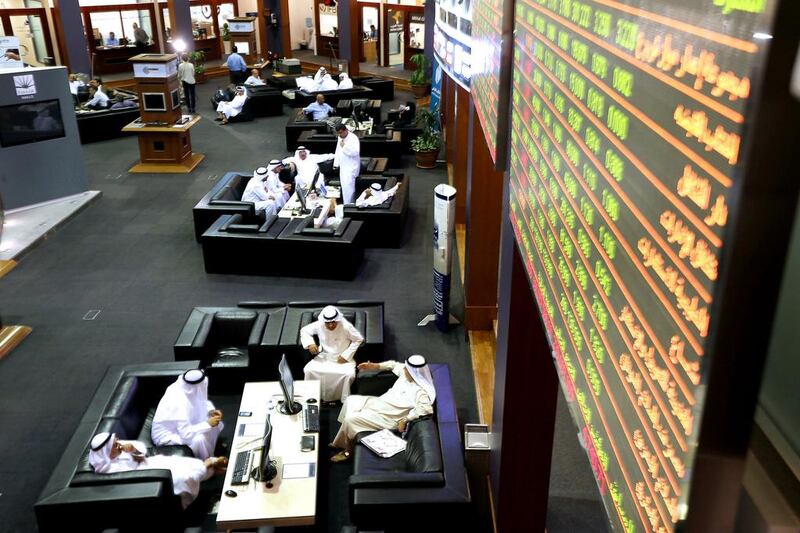GCC bond markets have had their fair share of macro risks this year – low oil prices, the Greek debt conundrum, the threat of US rate increases and more recently the devaluation of the Chinese yuan.
One could easily be forgiven for expecting plenty of blood on the floor. However, seeing through the shroud of day-to-day volatility, we find that year-to-date total returns in the UAE debt markets have remained relatively healthy.
Year to date total return on UAE bonds is at about 2.2 per cent. This compares with a return of 1.1 per cent on US investment grade bonds and a loss of 0.2 per cent on US investment grade corporate bonds. The average yield on UAE bonds has fallen from 2.9 per cent on January 1 to 2.7 per cent at the end of last week, while that on US investment grade bonds has risen from 2 per cent to 2.1 per cent – when a bond’s yield goes up, its price comes down and vice versa.
GCC markets’ outperformance, despite weaker oil prices, is attributed to several factors including its small size, strong local bid, good health of local corporates and high foreign reserves of the local sovereigns.
While oil prices are expected to remain below the budget break-even point for most GCC sovereigns, their large foreign reserves (over US$2.5 trillion) and low current debt levels have allowed them to maintain expenditure largely at previous levels, which in turn is supporting economic growth in the range of 3 per cent to 5 per cent per annum compared with GDP growth of 2.5 per cent in the United States and below 1.5 per cent in the euro zone.
By contrast, other oil exporting countries such as Russia and Venezuela are seeing sharp contractions in their economies as reduced oil revenues restrict governments’ ability to stimulate growth.
Despite clear justification for the devaluation of yuan, the Chinese central bank’s shift in strategy has certainly sparked the risk of spreading a currency war. Volatility in the global financial markets has escalated materially over the last few weeks as concerns mount that China is facing a bleaker economic outlook than investors had realised. However, the GCC bond market has remained largely unaffected by the yuan rout.
UAE equity markets have fallen in the last month but we link that more to oil prices than to a weaker yuan. China is one of the UAE’s largest trading partners accounting for $15.8 billion or about 8 per cent of exports and $39bn or approximately 17 per cent of imports.
The UAE, being a net importer to the tune of $21bn, will be able to buy electronics, machinery, apparel, furniture, etc at much cheaper prices.
Foreign investor participation in the GCC market is low (below 20 per cent for bonds and below 10 per cent for equities) compared with other emerging markets such as Brazil, Russia and China, mainly because not many GCC companies are included in global debt or equity indices. Also, the foreign investor base is well diversified between the US, Europe, Asia and funds focused on Islamic finance. This facilitates liquidity from Europe and Asia to fill the shoes left by the US investors every time the rate rise fears frighten the dollar-based investors.
Total GCC bond market is less than 10 per cent of the regional GDP compared with over 200 per cent of GDP in the developed economies. The small size of the GCC bond market ensures demand far outstripping supply. Local investors tend to buy and hold the securities close to their chest, even in times of negative news flow, as alternate investment products are scarce. Also future supply pipeline for new bonds look bleak with total issue volume of bonds this year is likely to be 20 per cent lower than last year. This skewed demand-supply dynamic is one of the fundamental pillars providing strength to the local GCC markets.
Weakening local currencies have negatively impacted the debt servicing burden of several companies in many emerging markets. However, most GCC currencies, directly or indirectly, are pegged to the dollar, helping to maintain a positive sentiment on GCC corporate issuers.
Despite the well telegraphed nature of the event, the impending US rate rise is a major wild card, not only for the GCC but also for the rest of emerging financial markets. However, as has been the case so far, we expect this risk to be a little less threatening for GCC than other emerging markets.
Anita Yadav, Head of Fixed Income Research, Emirates NBD.
* Our regular contributor Tim Fox returns soon.
Follow The National's Business section on Twitter






